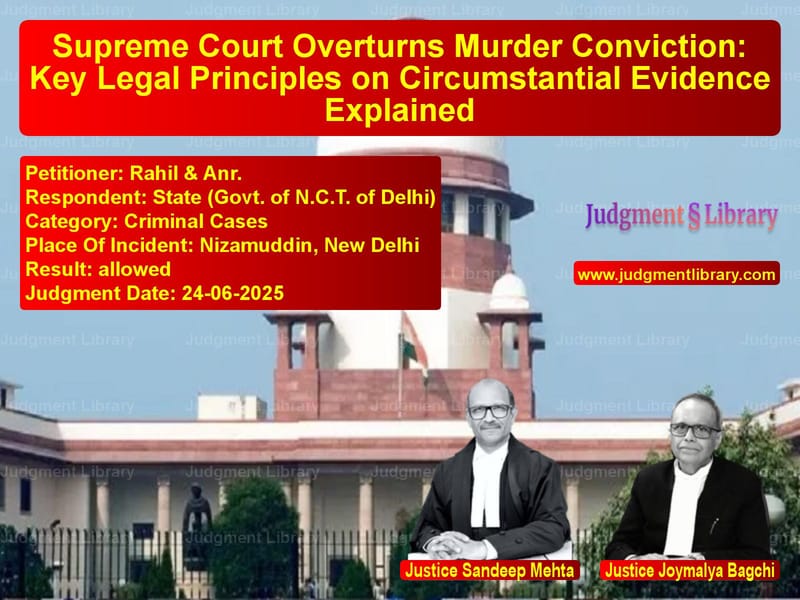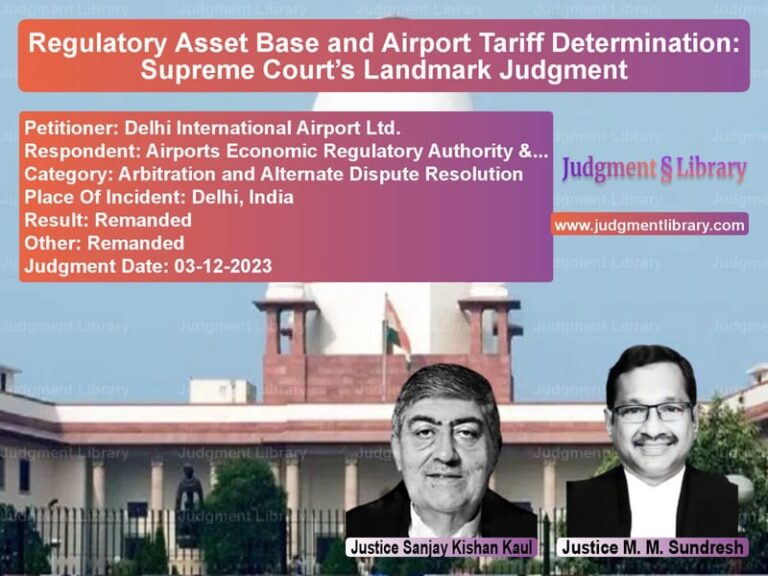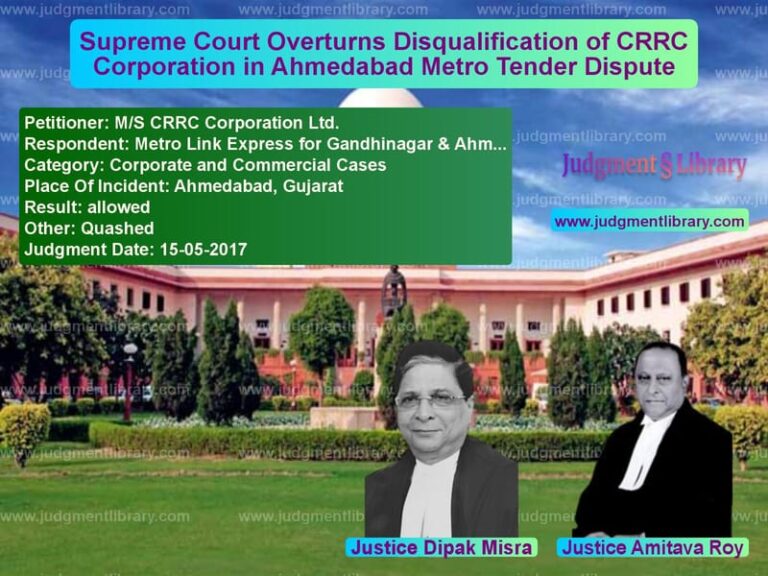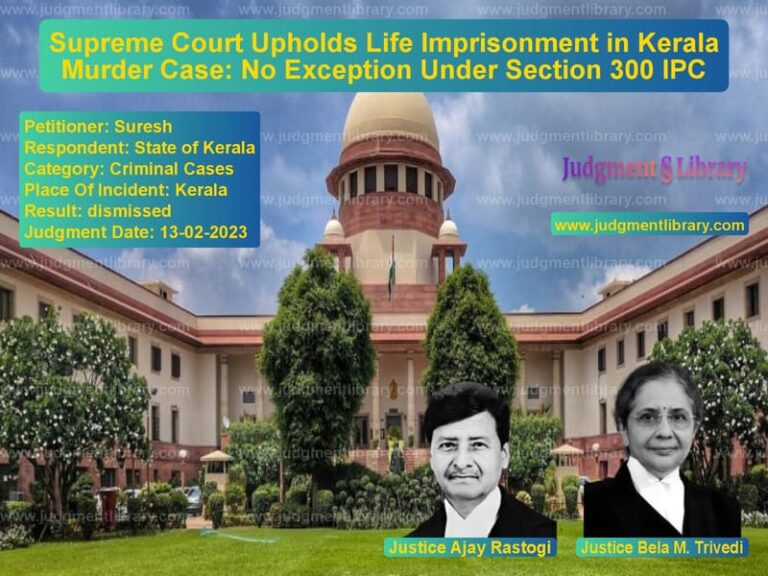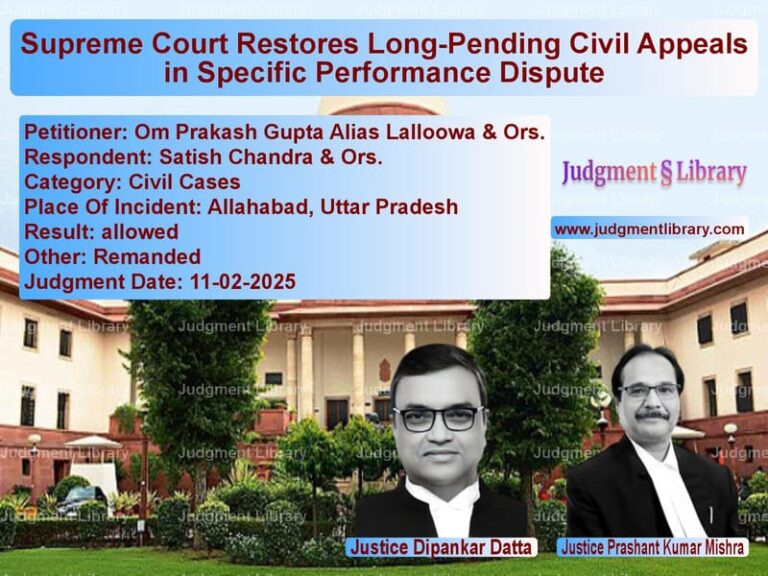Supreme Court Overturns Murder Conviction: Key Legal Principles on Circumstantial Evidence Explained
In a significant criminal law judgment, the Supreme Court of India has overturned the murder convictions of two appellants, highlighting crucial legal principles regarding circumstantial evidence, presumption of innocence, and the burden of proof in criminal trials. The case, which traveled through multiple judicial forums over more than two decades, serves as an important reminder of the fundamental protections afforded to accused persons under Indian law.
The Background of the Case
The legal saga began with a property dispute between co-accused Suraiya and the deceased Shakeel ur Rehman. Suraiya had entered into a sale agreement with Shakeel for purchase of property number 15/1 Jaipur Estate, Nizamuddin, New Delhi. Before the sale deed could be executed, on April 6, 2003, Shakeel started constructing a boundary wall on the property, leading to resistance from Suraiya and her associates. A quarrel ensued, during which Suraiya allegedly threatened to kill Shakeel. The matter was reported to police and amicably settled. Later that evening at 7:30 pm, Suraiya allegedly called Shakeel on his landline and asked him to come to her residence. Thereafter, Shakeel went missing.
The Legal Journey Through Courts
Shakeel’s brother Aniq ur Rehman lodged a missing person report on April 7, 2003, which later became a formal FIR under Section 365/34 IPC against Suraiya, her brother Mohd. Fazal, and the appellants Rahil and Noor Ahmed (Suraiya’s son and husband respectively). During investigation, Fazal and one Mohan Seth were arrested, and on their disclosure statements, Shakeel’s decomposed body was recovered near Haridwar. The postmortem doctor opined that death was due to asphyxia resulting from strangulation and had occurred 3 to 5 days earlier.
The trial court convicted Suraiya and Mohd. Fazal under Section 302/34 IPC but acquitted the appellants Rahil and Noor Ahmed. The State challenged this acquittal before the High Court, which reversed the trial court’s decision and convicted the appellants under Section 302/34 IPC along with Suraiya. The High Court acquitted Mohd. Fazal of the murder charge but upheld his conviction under Section 201 IPC. The appellants then approached the Supreme Court, while Suraiya’s appeal abated due to her death.
Arguments Before the Supreme Court
Mr. Mohd. Irshad Hanif, learned counsel for the appellants, argued that the High Court erred in reversing a well-reasoned acquittal on the basis of vague surmises and inferences. He contended that mere suspicion howsoever high cannot take the place of proof.
On the other hand, Mr. Rajan Kumar Chourasia, learned counsel for the Respondent-State, argued that the findings of the trial court were wholly perverse and against the weight of evidence on record. He pointed to witnesses PW-3, 4 and 6 who unequivocally deposed that the appellant had received a phone call and gone to the house of Suraiya. He emphasized that the appellants being son and husband of Suraiya, their presence at the place of occurrence was most natural, and no plea of alibi was taken by them. He also relied on CDRs showing active phone calls between Rahil and Mohd. Fazal on the night of April 6, 2003, and tower location data placing Rahil’s phone at Nizamuddin.
The Supreme Court’s Analysis
The Supreme Court began its analysis by reiterating the fundamental principle that in an appeal against acquittal, the appellate court would not interfere with the finding of the trial court unless the same finding is wholly perverse or against the weight of evidence on record. The Court emphasized that when acquittal is based on findings which are reasonable and plausible, the appellate court would be slow to interfere as the presumption of innocence stands re-enforced by the acquittal.
The Court then examined the High Court’s reasoning point by point. The High Court had concluded that the presence of appellants in the house when the deceased was called was proved, relying partly on Noor Ahmed’s response to question no.7 in his examination under Section 313 Cr.P.C. However, the Supreme Court found this interpretation incorrect, noting that the response actually indicated that after the amicable settlement at the police station, Shakeel ur Rehman came to his own house, not that of Suraiya/Noor Ahmed.
The Court further observed that there was no direct evidence that Shakeel had actually gone to Suraiya’s residence on the fateful evening. While witnesses stated that after receiving a phone call, Shakeel left his residence stating he was going to Suraiya’s house, the sole evidence that he actually went there came from an embellished statement of PW-3 who claimed he accompanied the deceased to Suraiya’s residence. The Court noted this version was stated for the first time in court and was significantly absent in the missing diary or FIR, casting doubt on its credibility.
The Court made a crucial observation about witness conduct: “Given such animosity had Shakeel ur Rehman left for Suraiya’s residence in the evening of 06.04.2003, and gone missing, it would be most natural for these witnesses to go to Suraiya’s residence and enquire of his whereabouts. None of the witnesses stated that they either visited Suraiya’s residence or inquired from her about Shakeel’s whereabouts. In these circumstances, possibility of the witnesses implicating Suraiya and other family members in the crime out of mere suspicion cannot be ruled out.”
Presumption of Presence and Electronic Evidence
The Supreme Court strongly criticized the High Court’s reasoning that appellants being family members ought to be presumed present in the house. The Court noted: “The High Court reversed the acquittal on the specious logic that appellants being the son and husband of Suraiya and ordinarily residing with her ought to be presumed to be present in the house. It is nobody’s case that the incident occurred in the dead hours of the night when all family members are expected to remain in the house.”
Regarding the CDR evidence against Rahil, the Court conducted a detailed analysis of the legal requirements for admissibility of electronic evidence. The Court held that the CDRs were inadmissible as secondary evidence without certification under Section 65-B(4) of the Evidence Act, despite objections being raised during trial. The Court emphasized: “Appellants during trial raised objections to admissibility of the secondary electronic evidence relating to Rahil which was marked as exhibit PW23/B-D. Thereby the prosecutor was put on due notice and had opportunity to fill the lacuna by producing the requisite certificate under Section 65-B(4) but did not do so.”
Even assuming the CDRs were admissible, the Court found them insufficient to prove Rahil’s presence at the crime scene. The Court explained: “Cell towers can reach approximately a half mile to two miles in city location. No evidence is led regarding the range of the said tower. It needs to be borne in mind that cell tower ranges widely vary and are dependent on a number of variables.” The Court noted that cell triangulation using multiple towers would have been more reliable than reference to a single tower.
Burden of Proof and Shifting Onus
The Supreme Court reiterated fundamental principles of criminal jurisprudence: “It is settled law in a criminal case whether based on direct or circumstantial evidence, the burden of proof always rests on the prosecution. Only when the prosecution discharges the initial onus, that is, proves the incriminating attending circumstances to establish the cause of death are within the ‘special knowledge’ of an accused does the onus shift and an adverse inference against such accused may be drawn if he fails to discharge such onus.”
The Court found that the prosecution had failed to discharge its initial burden of proving the appellants’ presence at the crime scene. The Court condemned the High Court’s approach of drawing adverse inferences under Section 106 of the Evidence Act without the prosecution first establishing foundational facts: “Such failure of the prosecution cannot be bridged by an inferential conclusion of presence of all inmates in the house to shift the onus on them to explain away the circumstances leading to Shakeel’s homicidal death. High Court failed to appreciate this lacuna in the prosecution case and illegally drew adverse inference against the appellants under Section 106 of Indian Evidence Act, 1872.”
Conclusion and Impact
In its final analysis, the Supreme Court held: “Accordingly, we hold that High Court was not justified in reversing the findings of acquittal on the basis of mere surmises and the impugned judgment to the extent that it convicts the appellants is liable to be set aside.” The Court allowed the appeal and set aside the convictions.
This judgment serves as an important reinforcement of fundamental criminal law principles in India. It underscores that convictions cannot be based on mere suspicion, family relationships, or speculative inferences. The prosecution must prove its case beyond reasonable doubt through reliable and admissible evidence. The decision also provides crucial guidance on the technical requirements for electronic evidence, ensuring that technological advances in investigation do not compromise the rights of the accused. In a legal system where the presumption of innocence is foundational, this judgment stands as a significant protection against wrongful convictions based on circumstantial evidence and questionable inferences.
Petitioner Name: Rahil & Anr..Respondent Name: State (Govt. of N.C.T. of Delhi).Judgment By: Justice Sandeep Mehta, Justice Joymalya Bagchi.Place Of Incident: Nizamuddin, New Delhi.Judgment Date: 24-06-2025.Result: allowed.
Don’t miss out on the full details! Download the complete judgment in PDF format below and gain valuable insights instantly!
Download Judgment: rahil-&-anr.-vs-state-(govt.-of-n.c.-supreme-court-of-india-judgment-dated-24-06-2025.pdf
Directly Download Judgment: Directly download this Judgment
See all petitions in Murder Cases
See all petitions in Evidence Law
See all petitions in Judgment by Sandeep Mehta
See all petitions in Judgment by Joymalya Bagchi
See all petitions in allowed
See all petitions in supreme court of India judgments June 2025
See all petitions in 2025 judgments
See all posts in Criminal Cases Category
See all allowed petitions in Criminal Cases Category
See all Dismissed petitions in Criminal Cases Category
See all partially allowed petitions in Criminal Cases Category

